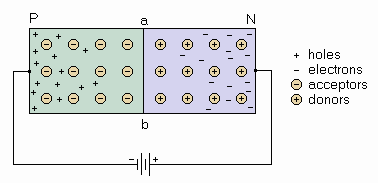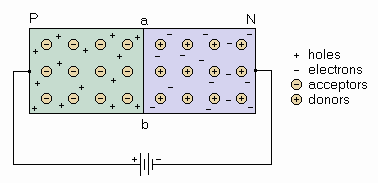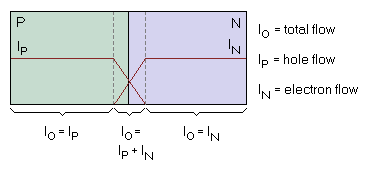| Transistor Basics is a free introductory textbook on transistors and their basic applications. See the editorial for more information.... |

|

Home  Basic Semiconductor Physics Basic Semiconductor Physics  Transistor Germanium Properties Transistor Germanium Properties  Reverse and Forward Bias Reverse and Forward Bias |
||






|
||
|
Reverse and Forward BiasAuthor: Leonard Krugman
Fig. 1-5. P-N junction with reverse bias. The connection of an external battery, illustrated in Fig. 1-5, is an example of reverse bias. The negative terminal attracts holes and concentrates them further to the left, while the positive terminal concentrates the electrons further to the right. There is no flow across the junction, since the effect of this connection is to increase the potential hill barrier.
Fig. 1-6. (A) P-N junction with forward bias.
Fig. 1-6. (B) Carrier conduction in P-N junction. One may well ask, "How much battery voltage is necessary?" Offhand, since the equivalent battery potential is in the neighborhood of a few tenths of a volt, an external battery of equal value should normally be considered sufficient. Unfortunately, a large part of the battery potential is dropped across the resistance of the P- and N-regions before the potential hill is reached. The voltage drop in these regions is proportional to the current flow through them; as the current increases due to the reduction of the potential hill, the drop across the P- and N-regions also increases, leaving even less of the external voltage available to reduce the junction barrier potential. An external battery of approximately one to two volts is required because of these factors.
|
||
Home  Basic Semiconductor Physics Basic Semiconductor Physics  Transistor Germanium Properties Transistor Germanium Properties  Reverse and Forward Bias Reverse and Forward Bias |
||
Last Update: 2007-07-12




